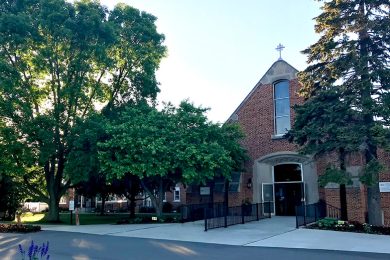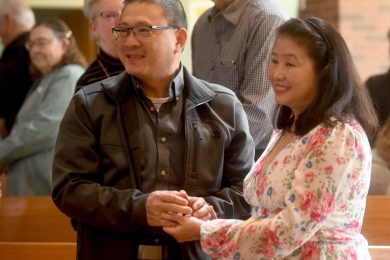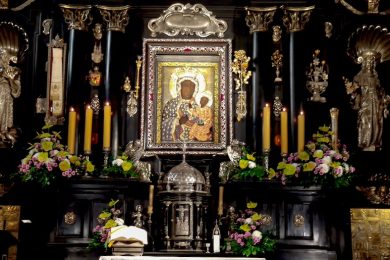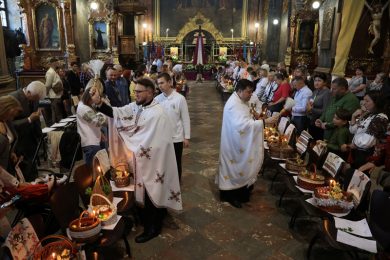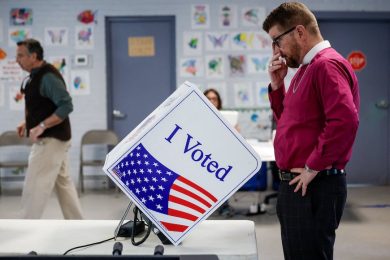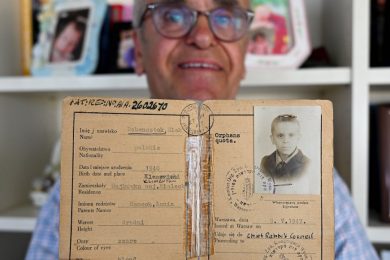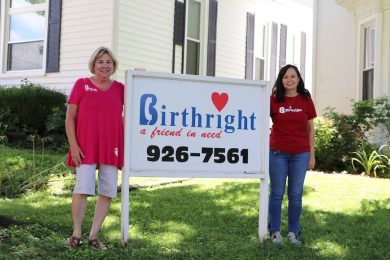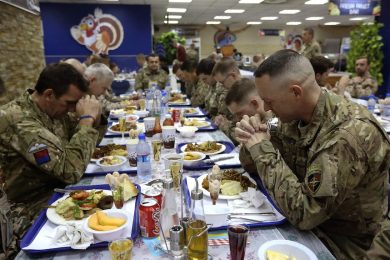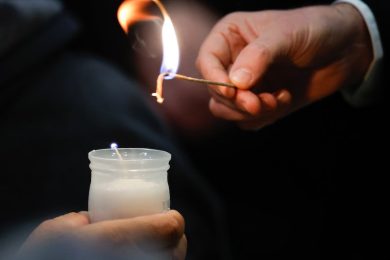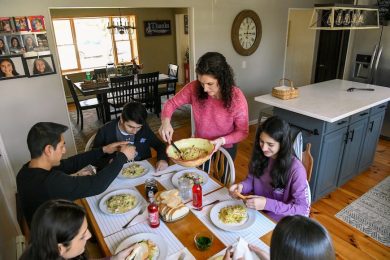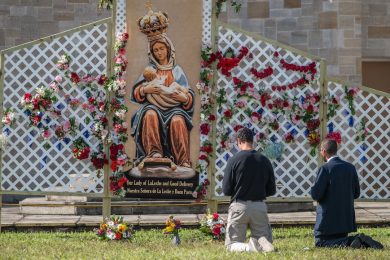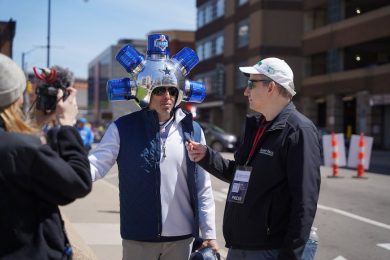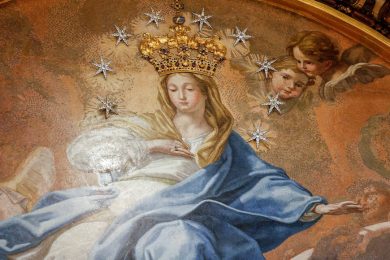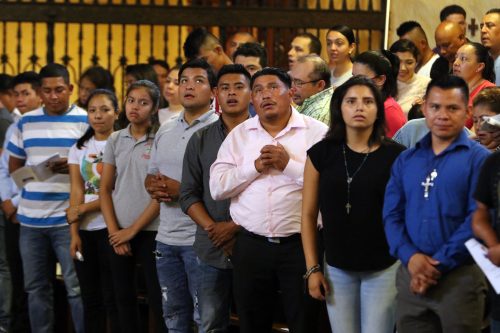By David Aquije | OSV News
May 27 was a special day for the Hispanic charismatic movement in New York as about 3,000 people processed through the streets of Manhattan to St. Patrick’s Cathedral to celebrate a Pentecost vigil. Led by New York Auxiliary Bishop Joseph Espaillat, participants called the celebration “a procession of hope.”
These hopeful expressions of faith reflect one of many realities of the Hispanic/Latino Catholic population in the United States. Hispanic, Latino, Chicano, Latinx, Mexican, Dominican, Puerto Rican, Peruvian, Bolivian, Cuban, Maya, Nahuatl, Quechua, Garifuna. Legal, “illegal,” asylum seeker, migrant … First, second, third generation, millennial, baby boomer. Black, white, mulato, mestizo, Native, indígena. Realities are often informed by immigration status, national origin, language, age and race, as well as social and political issues. No one identity can encapsulate the complex diversity of the roughly 62.6 million Hispanic/Latinos in the United States — over 40% of whom identify as Catholics.
With its own hope of a vibrant future for Hispanic/Latino Catholics in the United States, the U.S. Conference of Catholic Bishops is set to vote on a new national plan for Hispanic/Latino Catholic ministry June 16. Ahead of that vote two prominent Hispanic Catholic leaders reflected on the impact this plan may have on the diverse group of Catholics it aims to serve.
Jesuit Father Allan Figueroa Deck, a distinguished scholar in pastoral theology and Latino studies at Loyola Marymount University in Los Angeles, is co-founder and first president of the National Catholic Council for Hispanic Ministry. Founded in 1991, the council is a group of Hispanic ministry offices, professional associations, pastoral institutes and centers, as well as apostolic movements, media publishers, laity and professionals working on Hispanic ministry through advocacy, education and networking.
“As we go through the synodal process, I presume that the significance of the emerging pastoral plan on Hispanic ministry is placed in the context of the reform of the church that is taking place in the world because of Pope Francis,” said Father Deck, referring to the Synod on Synodality that will meet in October and the worldwide preparation process underway. He underscored that such reform is framed in the “vision of Vatican II as it was interpreted in Latin America through the work of the bishops of CELAM,” the Latin American bishops’ conference.
At the 2007 CELAM conference held in Aparecida, Brazil, where then-Cardinal Jorge Mario Bergoglio played a significant role, the Latin American bishops issued a letter, known as the Aparecida document, that many analysts say shaped Pope Francis’ current worldview. That document influenced Hispanic ministry in the U.S. and is an introduction to the vision of the universal church, said Father Deck.
At the Fifth National Encuentro (V Encuentro) gathering, about 3,000 Hispanic/Latino ministry leaders from dioceses, ecclesial movements, schools, universities and Catholic organizations from across the country convened to discern pastoral priorities and strategies for Hispanic/Latino ministries.
The four-year process that involved thousands at the parish, diocesan and regional levels culminated in 2018 at a national gathering. In 2019, a U.S. delegation — which included Archbishop José H. Gomez of Los Angeles — presented its conclusions and proceedings to Pope Francis. The new pastoral plan that will be discussed by the U.S. bishops is said to have been informed by the recommendations and national priorities identified by the V Encuentro process.
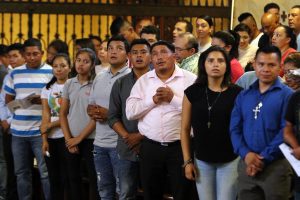
Recent data released in 2022 stated that there are about 62 million Catholics in the U.S. Of them, at least 27 million, 43%, are Hispanic/Latino.
Of the nearly 17,000 parishes in the country, around 4,500 offer Masses in Spanish. Of 37,300 U.S.-based priests, only 3,000 of them are Hispanic/Latino and of these, 2,000 are foreign-born, according to media reports.
In Texas, the Houston Chronicle recently reported that the percentage of Hispanic Catholics has surpassed other religions in the second-largest U.S. state and the rest of the Southwest, where evangelical Protestants were the majority for decades.
An April report from the Pew Research Center indicates that Catholics remain the largest religious group among Latinos in the United States, even as their share among Latino adults has steadily declined over the past decade. As of 2022, the report said, 43% of Hispanic adults identify as Catholic, down from 67% in 2010.
Hosffman Ospino, a professor of theology and religious education at Boston College who co-chaired the process of the V Encuentro, cautions that the new pastoral plan for Hispanic ministry should be treated “as a point of reference to organize evangelization activities not only with Hispanics but with the entire Catholic community.”
“A plan that would treat the Hispanic community as an isolated or marginal group within the larger church, and assume that it is only for Hispanics, would miss the point of the synodal conversation that led to it, i.e., the V Encuentro,” he told OSV News. “The process of the V Encuentro was an opportunity to discern ways for Hispanics to assume protagonism to continue to build strong families and faith communities in this country.”
After COVID-19, “many Hispanic Catholics still live in a survival mode in parishes that struggle financially and in parishes where they are still treated as visitors or people who are borrowing the premises,” Ospino said.
He added that “this has been a constant for them, before, during and after the pandemic,” and it is an area of growth for many faith communities and pastoral leaders.
This new pastoral plan would be a way to respond to the signs of the times, such as when the National Catholic Welfare Council, predecessor of the USCCB, established the Office for the Spanish Speaking in 1945.
Since then, key Hispanic/Latino ministry moments include the appointment of the first U.S. Hispanic bishop in 1970, Archbishop Patrick Flores; the five national Encuentro processes that have been convened since 1972; the approval of the first National Plan for Hispanic Ministry in 1987; the four Roots and Wings congresses held since 1992; and the incorporation of the Secretariat for Hispanic Affairs under the USCCB Secretariat for Cultural Diversity in the Church. Other initiatives, such as the V Encuentro process and subsequent events, have sought to strengthen leadership formation and participation of Latino Catholics.
“My hope is that the pastoral plan for Hispanic ministry raises awareness about the need to support and accompany Hispanic Catholics because it is the right thing to do,” Ospino said. “I would like this plan to be seen as a plan to be church, capitalizing on the many gifts that Hispanic Catholics bring to the church in the United States.”
– – –
David Aquije writes from OSV News from New York.

